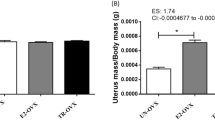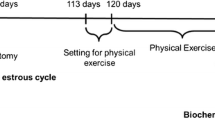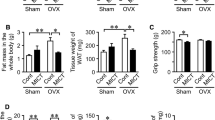Abstract
Decreased estrogen production is associated with changes in the skeletal, cardiovascular and muscular systems. At the level of skeletal muscles, it has been shown that a reduction in force production occurs at menopause but the underlying mechanisms are still unknown. The aim of the study was to investigate the effects of ovariectomy on myosin heavy chain (MyHC) composition. Additionally, we studied the effects of physical activity and the combined effects of physical activity and estrogen treatment on MyHC content in ovariectomised (OX) animals. Twenty-five rats were randomly assigned to five different groups: controls, runners, OX, ovariectomised runners and ovariectomised runners receiving estrogen. Exercise consisted of voluntary running for 5 weeks. Two muscles were analysed: m. extensor digitorum longus, EDL, (fast muscle) and m. soleus (slow muscle). MyHC content was analysed on 8% gel electrophoresis. The level of running activity is reduced in OX animals and estrogen administration is associated with the normalisation of the level of physical activity. Ovariectomy induces a shift from fast to slow MyHC isoforms in both the soleus and EDL. When OX animals are allowed to run, alterations in MyHC isoforms are still observed in the EDL but not in the soleus. When physical activity is combined with estrogen treatment no alterations are observed in both muscles. In conclusion, this study shows that ovariectomy induces alterations in the contractile properties of skeletal muscles and that physical activity in combination with estrogen treatment are associated with the maintenance of slow and fast muscle characteristics.
Similar content being viewed by others
References
Anantharaman-barr HG and Decombaz J (1989) The effect of wheel running and the estrous cycle on energy expenditure in female rats. Physiol Behav 46(2): 259-263.
Butler-browne GS and Whalen RG (1984) Myosin isozyme transitions occurring during the postnatal development of the rat soleus muscle. Dev-Biol 102: 324-334.
Cushing BS, Marhenke S and McClure PA (1995) Estradiol concentration and the regulation of locomotor activity. Physiol Behav 58(5): 953-957.
Dionne IJ, Kinaman KA and Poehlman ET (2000) Sarcopenia and muscle function during menopause and hormone-replacement therapy. J Nutr Health Aging 4(3): 156-161.
Greeves JP, Cable NT, Reilly T and Kingsland C (1999) Changes in muscle strength in women following the menopause: a longitudinal assessment of the eficacy of hormone replacement therapy. Clin Sci (Lond) 97(1): 79-84.
Karp JD and Powers JB (1993) Photoperiodic and pineal influences on estrogen-stimulated behaviors in female Syrian hamsters. Physiol Behav 54(1): 19-28.
Kent S, Hurd M and Satino. E (1991) Interactions between body temperature and wheel running over the estrous cycle in rats. Physiol Behav 49(6): 1079-1084.
Larsson L and Ramamurthy B (2000) Aging-related changes in skeletal muscle. Mechanisms and interventions. Drugs Aging 17(4): 303-316.
Mcgoldrick T, Phillips SK, Bruce SA and Woledge RC (1998) Changes in isometric force of mouse soleus muscle during the oestrous cycle. Pflugers Arch 437: 70-73.
Meeuwsen IB, Samson MM and Verhaa HJ (2000) Evaluation of the applicability of HRT as a preservative of muscle strength in women. Maturitas 36(1): 49-61.
Pette D and Staron RS (2001) Transitions of muscle fiber phenotypic profiles. Histochem Cell Biol 115(5): 359-372.
Phillips SK, Sanderson AG, Birch K, Bruce SA and Woledge RC (1996) Changes in maximal voluntary force of human adductor pollicis muscle during the menstrual cycle. J Physiol 15(496): 551-557.
Schiaffno S and Reggiani C (1996) Molecular diversity of myofibrillar proteins: gene regulation and functional significance. Physiol Rev 76: 371-423.
Skelton DA, Phillips SK, Bruce SA, Naylor CH and Woledge RC (1999) Hormone replacement therapy increases isometric muscle strength of adductor pollicis in post-menopausal women. Clin Sci (Lond) 96(4): 357-364.
Staron RS, Kraemer WJ, Hikida RS, Fry AC, Murray JD and Campos GE (1999) Fiber type composition of four hindlimb muscles of adult Fisher 344 rats. Histochem Cell Biol 111(2): 117-123.
Staron RS, Kraemer WJ, Hikida RS, Reed DW, Murray JD, Campos GE and Gordon SE (1998) Comparison of soleus muscles from rats exposed to microgravity for 10 versus 14 days. Histochem Cell Biol 110(1): 73-80.
Talmadge RJ and Roy RR (1993) Electrophoretic separation of rat skeletal muscle myosin heavy-chain isoforms. J Appl Physiol 75(5): 2337-2340.
Warren GL, Lowe DA, Inman CL, Orr OM, Hogan HA, Bloomfield SA and Armstrong RB (1996) Estradiol effect on anterior crural muscles-tibial bone relationship and susceptibility to injury. J Appl Physiol 80(5): 1660-1665.
Wollnik F and Turek FW (1988) Estrous correlated modulations of circadian and ultradian wheel-running activity rhythms in LEW/ Ztm rats. Physiol Behav 43(3): 389-396.
Author information
Authors and Affiliations
Rights and permissions
About this article
Cite this article
Kadi, F., Karlsson, C., Larsson, B. et al. The effects of physical activity and estrogen treatment on rat fast and slow skeletal muscles following ovariectomy. J Muscle Res Cell Motil 23, 335–339 (2002). https://doi.org/10.1023/A:1022071114344
Issue Date:
DOI: https://doi.org/10.1023/A:1022071114344




